Jiyuan Liu
Intra-view and Inter-view Correlation Guided Multi-view Novel Class Discovery
Jul 16, 2025Abstract:In this paper, we address the problem of novel class discovery (NCD), which aims to cluster novel classes by leveraging knowledge from disjoint known classes. While recent advances have made significant progress in this area, existing NCD methods face two major limitations. First, they primarily focus on single-view data (e.g., images), overlooking the increasingly common multi-view data, such as multi-omics datasets used in disease diagnosis. Second, their reliance on pseudo-labels to supervise novel class clustering often results in unstable performance, as pseudo-label quality is highly sensitive to factors such as data noise and feature dimensionality. To address these challenges, we propose a novel framework named Intra-view and Inter-view Correlation Guided Multi-view Novel Class Discovery (IICMVNCD), which is the first attempt to explore NCD in multi-view setting so far. Specifically, at the intra-view level, leveraging the distributional similarity between known and novel classes, we employ matrix factorization to decompose features into view-specific shared base matrices and factor matrices. The base matrices capture distributional consistency among the two datasets, while the factor matrices model pairwise relationships between samples. At the inter-view level, we utilize view relationships among known classes to guide the clustering of novel classes. This includes generating predicted labels through the weighted fusion of factor matrices and dynamically adjusting view weights of known classes based on the supervision loss, which are then transferred to novel class learning. Experimental results validate the effectiveness of our proposed approach.
HopWeaver: Synthesizing Authentic Multi-Hop Questions Across Text Corpora
May 21, 2025Abstract:Multi-Hop Question Answering (MHQA) is crucial for evaluating the model's capability to integrate information from diverse sources. However, creating extensive and high-quality MHQA datasets is challenging: (i) manual annotation is expensive, and (ii) current synthesis methods often produce simplistic questions or require extensive manual guidance. This paper introduces HopWeaver, the first automatic framework synthesizing authentic multi-hop questions from unstructured text corpora without human intervention. HopWeaver synthesizes two types of multi-hop questions (bridge and comparison) using an innovative approach that identifies complementary documents across corpora. Its coherent pipeline constructs authentic reasoning paths that integrate information across multiple documents, ensuring synthesized questions necessitate authentic multi-hop reasoning. We further present a comprehensive system for evaluating synthesized multi-hop questions. Empirical evaluations demonstrate that the synthesized questions achieve comparable or superior quality to human-annotated datasets at a lower cost. Our approach is valuable for developing MHQA datasets in specialized domains with scarce annotated resources. The code for HopWeaver is publicly available.
Active-Passive Federated Learning for Vertically Partitioned Multi-view Data
Sep 06, 2024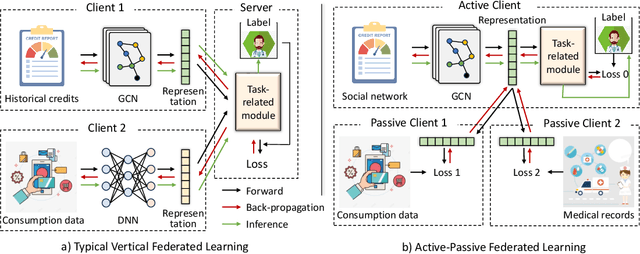


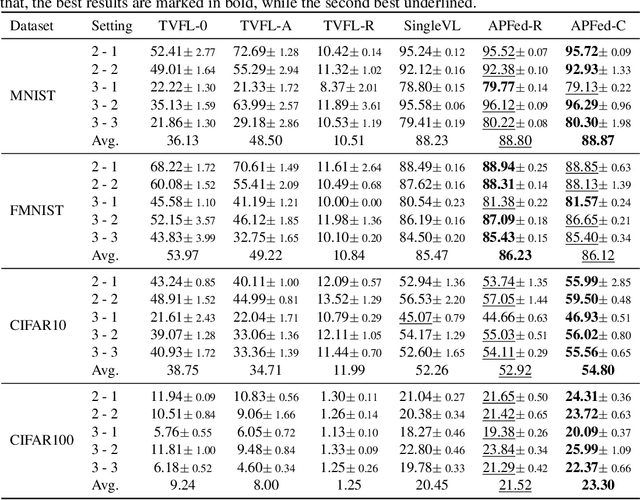
Abstract:Vertical federated learning is a natural and elegant approach to integrate multi-view data vertically partitioned across devices (clients) while preserving their privacies. Apart from the model training, existing methods requires the collaboration of all clients in the model inference. However, the model inference is probably maintained for service in a long time, while the collaboration, especially when the clients belong to different organizations, is unpredictable in real-world scenarios, such as concellation of contract, network unavailablity, etc., resulting in the failure of them. To address this issue, we, at the first attempt, propose a flexible Active-Passive Federated learning (APFed) framework. Specifically, the active client is the initiator of a learning task and responsible to build the complete model, while the passive clients only serve as assistants. Once the model built, the active client can make inference independently. In addition, we instance the APFed framework into two classification methods with employing the reconstruction loss and the contrastive loss on passive clients, respectively. Meanwhile, the two methods are tested in a set of experiments and achieves desired results, validating their effectiveness.
Contrastive Continual Multi-view Clustering with Filtered Structural Fusion
Sep 26, 2023
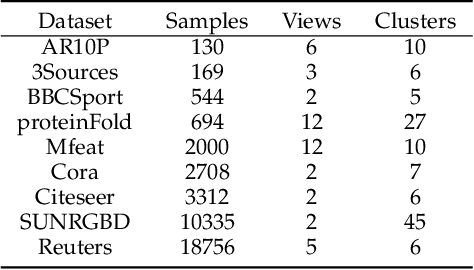
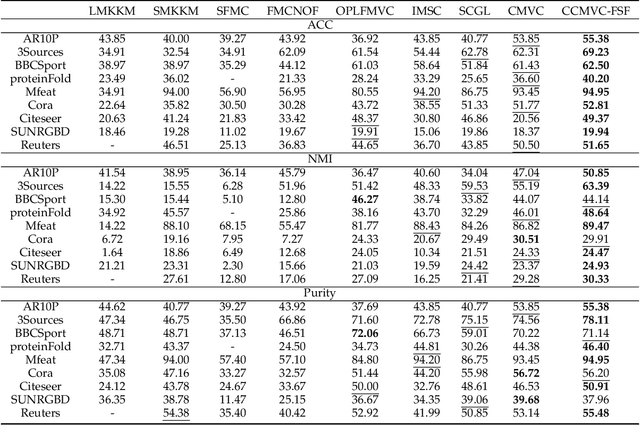

Abstract:Multi-view clustering thrives in applications where views are collected in advance by extracting consistent and complementary information among views. However, it overlooks scenarios where data views are collected sequentially, i.e., real-time data. Due to privacy issues or memory burden, previous views are not available with time in these situations. Some methods are proposed to handle it but are trapped in a stability-plasticity dilemma. In specific, these methods undergo a catastrophic forgetting of prior knowledge when a new view is attained. Such a catastrophic forgetting problem (CFP) would cause the consistent and complementary information hard to get and affect the clustering performance. To tackle this, we propose a novel method termed Contrastive Continual Multi-view Clustering with Filtered Structural Fusion (CCMVC-FSF). Precisely, considering that data correlations play a vital role in clustering and prior knowledge ought to guide the clustering process of a new view, we develop a data buffer with fixed size to store filtered structural information and utilize it to guide the generation of a robust partition matrix via contrastive learning. Furthermore, we theoretically connect CCMVC-FSF with semi-supervised learning and knowledge distillation. Extensive experiments exhibit the excellence of the proposed method.
Scalable Incomplete Multi-View Clustering with Structure Alignment
Aug 31, 2023



Abstract:The success of existing multi-view clustering (MVC) relies on the assumption that all views are complete. However, samples are usually partially available due to data corruption or sensor malfunction, which raises the research of incomplete multi-view clustering (IMVC). Although several anchor-based IMVC methods have been proposed to process the large-scale incomplete data, they still suffer from the following drawbacks: i) Most existing approaches neglect the inter-view discrepancy and enforce cross-view representation to be consistent, which would corrupt the representation capability of the model; ii) Due to the samples disparity between different views, the learned anchor might be misaligned, which we referred as the Anchor-Unaligned Problem for Incomplete data (AUP-ID). Such the AUP-ID would cause inaccurate graph fusion and degrades clustering performance. To tackle these issues, we propose a novel incomplete anchor graph learning framework termed Scalable Incomplete Multi-View Clustering with Structure Alignment (SIMVC-SA). Specially, we construct the view-specific anchor graph to capture the complementary information from different views. In order to solve the AUP-ID, we propose a novel structure alignment module to refine the cross-view anchor correspondence. Meanwhile, the anchor graph construction and alignment are jointly optimized in our unified framework to enhance clustering quality. Through anchor graph construction instead of full graphs, the time and space complexity of the proposed SIMVC-SA is proven to be linearly correlated with the number of samples. Extensive experiments on seven incomplete benchmark datasets demonstrate the effectiveness and efficiency of our proposed method. Our code is publicly available at https://github.com/wy1019/SIMVC-SA.
One-step Multi-view Clustering with Diverse Representation
Jun 27, 2023
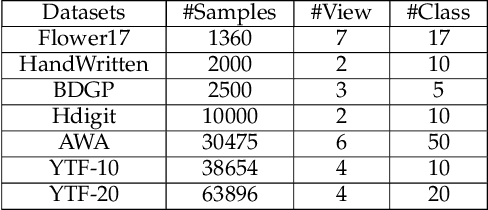
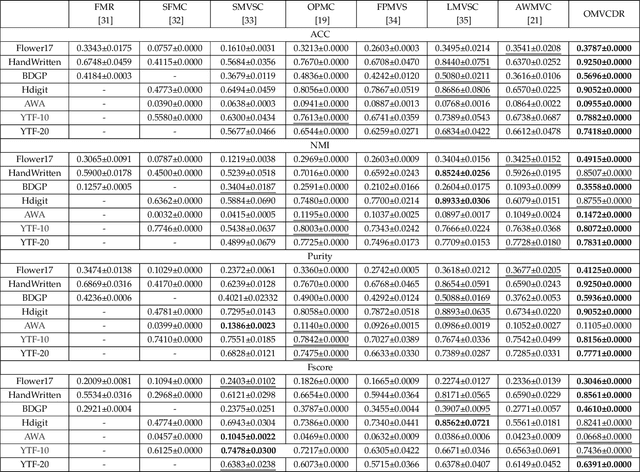

Abstract:Multi-view clustering has attracted broad attention due to its capacity to utilize consistent and complementary information among views. Although tremendous progress has been made recently, most existing methods undergo high complexity, preventing them from being applied to large-scale tasks. Multi-view clustering via matrix factorization is a representative to address this issue. However, most of them map the data matrices into a fixed dimension, limiting the model's expressiveness. Moreover, a range of methods suffers from a two-step process, i.e., multimodal learning and the subsequent $k$-means, inevitably causing a sub-optimal clustering result. In light of this, we propose a one-step multi-view clustering with diverse representation method, which incorporates multi-view learning and $k$-means into a unified framework. Specifically, we first project original data matrices into various latent spaces to attain comprehensive information and auto-weight them in a self-supervised manner. Then we directly use the information matrices under diverse dimensions to obtain consensus discrete clustering labels. The unified work of representation learning and clustering boosts the quality of the final results. Furthermore, we develop an efficient optimization algorithm with proven convergence to solve the resultant problem. Comprehensive experiments on various datasets demonstrate the promising clustering performance of our proposed method.
Fast Continual Multi-View Clustering with Incomplete Views
Jun 04, 2023



Abstract:Multi-view clustering (MVC) has gained broad attention owing to its capacity to exploit consistent and complementary information across views. This paper focuses on a challenging issue in MVC called the incomplete continual data problem (ICDP). In specific, most existing algorithms assume that views are available in advance and overlook the scenarios where data observations of views are accumulated over time. Due to privacy considerations or memory limitations, previous views cannot be stored in these situations. Some works are proposed to handle it, but all fail to address incomplete views. Such an incomplete continual data problem (ICDP) in MVC is tough to solve since incomplete information with continual data increases the difficulty of extracting consistent and complementary knowledge among views. We propose Fast Continual Multi-View Clustering with Incomplete Views (FCMVC-IV) to address it. Specifically, it maintains a consensus coefficient matrix and updates knowledge with the incoming incomplete view rather than storing and recomputing all the data matrices. Considering that the views are incomplete, the newly collected view might contain samples that have yet to appear; two indicator matrices and a rotation matrix are developed to match matrices with different dimensions. Besides, we design a three-step iterative algorithm to solve the resultant problem in linear complexity with proven convergence. Comprehensive experiments on various datasets show the superiority of FCMVC-IV.
Adversarial Attack with Raindrops
Feb 28, 2023Abstract:Deep neural networks (DNNs) are known to be vulnerable to adversarial examples, which are usually designed artificially to fool DNNs, but rarely exist in real-world scenarios. In this paper, we study the adversarial examples caused by raindrops, to demonstrate that there exist plenty of natural phenomena being able to work as adversarial attackers to DNNs. Moreover, we present a new approach to generate adversarial raindrops, denoted as AdvRD, using the generative adversarial network (GAN) technique to simulate natural raindrops. The images crafted by our AdvRD look very similar to the real-world raindrop images, statistically close to the distribution of true raindrop images, and more importantly, can perform strong adversarial attack to the state-of-the-art DNN models. On the other side, we show that the adversarial training using our AdvRD images can significantly improve the robustness of DNNs to the real-world raindrop attacks. Extensive experiments are carried out to demonstrate that the images crafted by AdvRD are visually and statistically close to the natural raindrop images, can work as strong attackers to DNN models, and also help improve the robustness of DNNs to raindrop attacks.
Multiple Kernel Clustering with Dual Noise Minimization
Jul 13, 2022

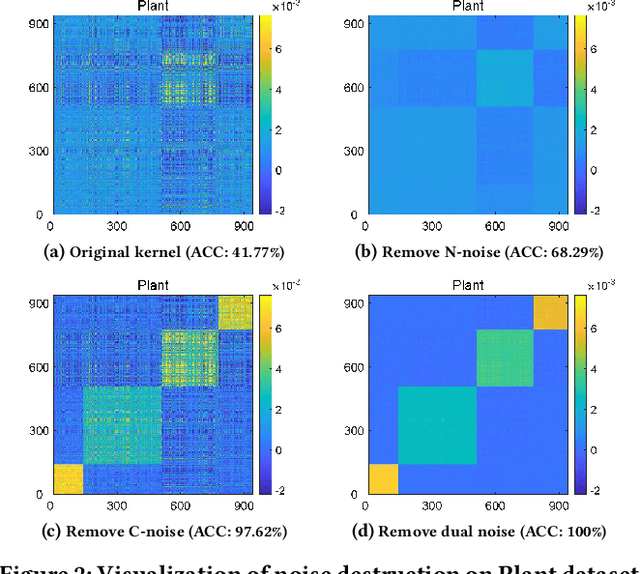
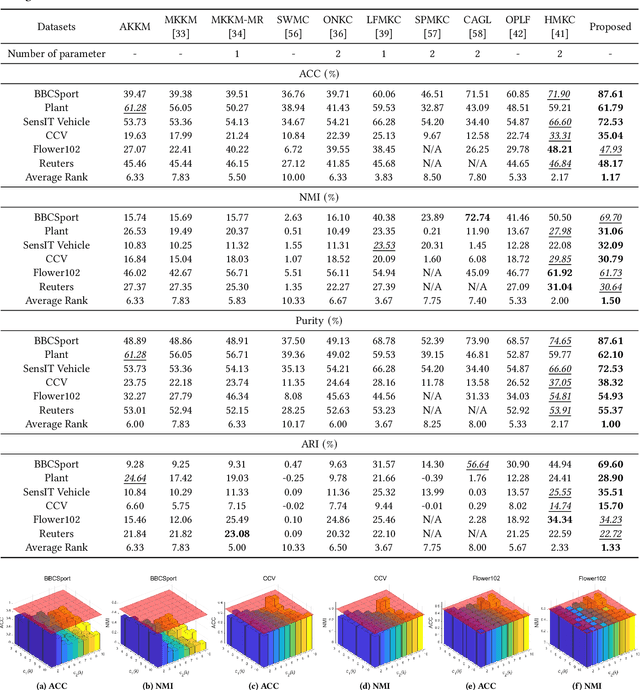
Abstract:Clustering is a representative unsupervised method widely applied in multi-modal and multi-view scenarios. Multiple kernel clustering (MKC) aims to group data by integrating complementary information from base kernels. As a representative, late fusion MKC first decomposes the kernels into orthogonal partition matrices, then learns a consensus one from them, achieving promising performance recently. However, these methods fail to consider the noise inside the partition matrix, preventing further improvement of clustering performance. We discover that the noise can be disassembled into separable dual parts, i.e. N-noise and C-noise (Null space noise and Column space noise). In this paper, we rigorously define dual noise and propose a novel parameter-free MKC algorithm by minimizing them. To solve the resultant optimization problem, we design an efficient two-step iterative strategy. To our best knowledge, it is the first time to investigate dual noise within the partition in the kernel space. We observe that dual noise will pollute the block diagonal structures and incur the degeneration of clustering performance, and C-noise exhibits stronger destruction than N-noise. Owing to our efficient mechanism to minimize dual noise, the proposed algorithm surpasses the recent methods by large margins.
Multi-view Clustering via Deep Matrix Factorization and Partition Alignment
May 10, 2021



Abstract:Multi-view clustering (MVC) has been extensively studied to collect multiple source information in recent years. One typical type of MVC methods is based on matrix factorization to effectively perform dimension reduction and clustering. However, the existing approaches can be further improved with following considerations: i) The current one-layer matrix factorization framework cannot fully exploit the useful data representations. ii) Most algorithms only focus on the shared information while ignore the view-specific structure leading to suboptimal solutions. iii) The partition level information has not been utilized in existing work. To solve the above issues, we propose a novel multi-view clustering algorithm via deep matrix decomposition and partition alignment. To be specific, the partition representations of each view are obtained through deep matrix decomposition, and then are jointly utilized with the optimal partition representation for fusing multi-view information. Finally, an alternating optimization algorithm is developed to solve the optimization problem with proven convergence. The comprehensive experimental results conducted on six benchmark multi-view datasets clearly demonstrates the effectiveness of the proposed algorithm against the SOTA methods.
 Add to Chrome
Add to Chrome Add to Firefox
Add to Firefox Add to Edge
Add to Edge